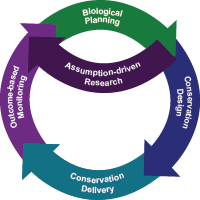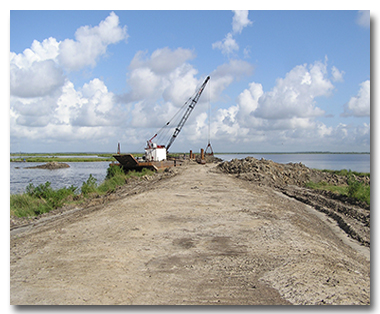
Who
The Gulf Coast Joint Venture is a regionally based, biologically driven, landscape oriented volunteer partnership of private, state, and federal conservation organizations dedicated to delivery of habitat conservation important to priority bird species.

What
The mission of the Gulf Coast Joint Venture is to advance the conservation of important bird habitats within the GCJV region through biological planning and design, implementation of habitat conservation actions, and focused monitoring and evaluation of the planning and implementation process.

Where
The Gulf Coast Joint Venture is a bird habitat conservation partnership that spans the coastal portions of Alabama, Mississippi, Louisiana, and Texas. It is one of 18 bird habitat joint ventures within the United States. The GCJV encompasses a wide variety of habitats, from seagrass beds, coastal marsh, and barrier islands to bottomland hardwood forest, fresh emergent wetlands, rice fields, and bald cypress swamps.
Announcing new conservation program!
GCJV Coastal Grassland Restoration Incentive Program (C-GRIP)
For more than 40 years grassland bird populations throughout Louisiana and Texas have been steadily declining. Among these declining birds is the Northern Bobwhite, a popular game bird and an icon of the American south. Also the Mottled Duck, a non-migratory North American waterfowl species, is reliant on grassland sites for nesting.
Since 1971, the population of Northern Bobwhites and Mottled Ducks in Louisiana and Texas has decreased dramatically. There are many factors that contribute to these population declines, but the primary cause is the loss of available suitable habitat needed to sustain these species. Conversion of native grasses to introduced pasture, overgrazing, suppression of fire, and brush encroachment have all had a significant impact on the ability of Louisiana and Texas grasslands to provide for the needs of Northern Bobwhite and Mottled Duck, as well as other grassland species. To address these drastic population declines, it is crucial that private landowners are encouraged and supported in their efforts to improve habitat for these grassland birds on the lands they own and manage.
What is C-GRIP?
C-GRIP provides financial incentives to private landowners for conducting habitat treatments that address the greatest limiting factors for suitability of grassland bird habitat on their property.In 2018 the Gulf Coast Joint Venture implemented C-GRIP in the central section of coastal Texas. Now, in 2022 C-GRIP is expanding to southwest Louisiana. Modeled after the Natural Resource Conservation Service (NRCS) Environmental Quality Incentive Program ( EQIP ) and other similar programs, C-GRIP is a voluntary program that reimburses private landowners a set payment rate for identified practices that generally fall into the categories of brush management, prescribed burning, native grass reseeding, and prescribed grazing. C-GRIP encourages and supports private landowners in their efforts to improve grassland habitats.
Submitting NAWCA Standard Grant?
You're in the right place!
North American Wetlands Conservation Act (NAWCA) grants increase bird populations and wetland habitat, while supporting local economies and American traditions such as hunting, fishing, bird watching, family farming, and cattle ranching. Wetlands protected by NAWCA provide valuable benefits such as flood control, reducing coastal erosion, improving water and air quality, and recharging ground water.
In the past two decades, the North American Wetlands Conservation Act has funded over 3,000 projects totaling $1.83 billion in grants. More than 6,350 partners have contributed another $3.75 billion in matching funds to affect 30 million acres of habitat.
ABOUT THE GRANTS PROGRAM
The NAWCA program provides matching grants to wetlands conservation projects in the United States, Canada, and Mexico. There is a Standard and a Small Grants Program. Both are competitive grants programs and require that grant requests be matched by partner contributions at no less than a 1-to-1 ratio.
Learn how to apply.
See the most recent grant announcements and project summaries.
The North American Wetlands Conservation Act was passed, in part, to support activities under the North American Waterfowl Management Plan, an international agreement that provides a strategy for the long-term protection of wetlands and associated uplands habitats needed by waterfowl and other migratory birds in North America. Program funding comes from appropriations, fines, penalties, and forfeitures; and from interest accrued on the fund. Funds from U.S. Federal sources may contribute towards a project, but are not eligible as match.
The NAWCA program operates in two cycles per year. Each cycle, eligible proposals are reviewed and ranked by the North American Wetlands Conservation Council, a nine-member council established by the Act. The Council may directly approve Small Grants. The Council recommends Standard Grants projects to the Migratory Bird Conservation Commission, a seven-member commission authorized by the Act to give final funding approval.
GCJV Priority Species
Click Here!
The Gulf Coast Joint Venture achieves it's conservation mission by focusing on a subset of avian species or guilds, based on the concept that the priority species represent other species that require the same type of habitat, so if habitat is conserved, enhanced, or created for one species, similiar species will benefit as well.







 700 Cajundome Blvd.
700 Cajundome Blvd.